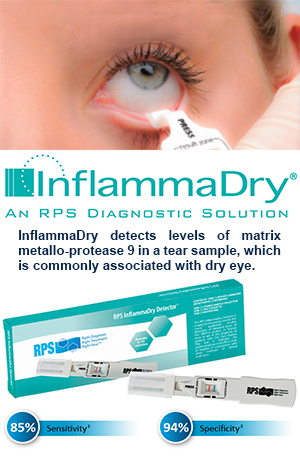
DRY EYES
Patients suffering dry eyes experience an inadequate amount of tear film on eyes. Patients who experience chronic dry eyes may be diagnosed with keratoconjunctivitis sicca, an eye disease characterized by dry eyes. It is also referred to as dry eye syndrome or chronic dry eye disease.
Dry Eye Syndrome (DES) can be caused by inadequate tear production or excessive tear evaporation. The UK’s National Health Service estimates that 17 percent to 30 percent of individuals suffer dry eyes at some point during their lives.
CAUSES
In order to treat dry eye syndrome, an eye care professional must first diagnose the cause. Dry eye syndrome can be caused by a number of factors ranging from dry air to underlying medical conditions. In many cases, dry eye syndrome patients experience problems creating and regulating a substance called tear film. Tear film is responsible for natural lubrication of the eye and is made of three basic layers. Issues with any of these layers can lead to chronic dry eye syndrome.
Poor Tear Quality
 Tear film is primarily composed of three layers: oil, water, and mucus. Oil comprises the tear film’s outer layer. Lipids, or fatty oils, are produced by small glands called the meibomian glands. The meibomian glands are located on the edge of the eyelids. The purpose of these lipids is to create an outer barrier of protection for the tear film.
Tear film is primarily composed of three layers: oil, water, and mucus. Oil comprises the tear film’s outer layer. Lipids, or fatty oils, are produced by small glands called the meibomian glands. The meibomian glands are located on the edge of the eyelids. The purpose of these lipids is to create an outer barrier of protection for the tear film.
The oils help to slow the evaporation of the underlying water layer so that the eyes can stay lubricated. If the meibomian glands fail to produce adequate amounts of lipids, the watery layer may evaporate too quickly, leading to dry eyes. Meibomian gland dysfunction may be caused by clogging or inflammation. Dysfunction can be caused by conditions such as blepharitis, or inflammation of the edges of the eyelids. Rosacea and other skin conditions can also cause meibomian gland dysfunction.
The middle layer of the tear film is mostly comprised of water. It also contains small amounts of salt. This layer is produced by the lacrimal glands, or tear glands. The purpose of the middle layer is to cleanse the eye and wash away irritants. A stringy discharge may occur if an inadequate amount of water is produced. This causes the oil and mucous layers to touch.
The innermost tear film layer is comprised of mucous. This layer allows the even spreading of tears over the eye’s surface. Dry spots may develop on the cornea, or front eye surface, if the amount of mucous is inadequate.
Decreased Tear Production
Decreased tear production can be caused by several conditions. Tear production decreases with age. For this reason, patients over the age of 50 commonly experience dry eyes. Studies show a link between menopause and dry eyes. It is believed that hormonal changes from menopause contribute to dry eye syndrome.
Laser-assisted in-situ keratomileusis (LASIK) surgery can cause decreased tear production. However, dry eye symptoms are usually temporary when created by laser eye surgeries. Patients who suffer tear gland damage from radiation or inflammation can also develop dry eye syndrome. Certain medical conditions may also decrease a patient’s tear production.
Decreased tear production may be caused by the following conditions:
- Lupus
- Rheumatoid arthritis
- Diabetes
- Sclerodoma
- Sjogren’s syndrome
- Thyroid disorders
- Vitamin A deficiency
Medications that Cause Dry Eyes
 There are a number of different medications that can cause or contribute to dry eye syndrome. In these cases, medical professionals and the patient may discuss ways to change these medications or alter dosage. In cases where the medication cannot be tampered with, the medical professional will recommend a separate solution to address the dry eyes without interfering with the medication.
There are a number of different medications that can cause or contribute to dry eye syndrome. In these cases, medical professionals and the patient may discuss ways to change these medications or alter dosage. In cases where the medication cannot be tampered with, the medical professional will recommend a separate solution to address the dry eyes without interfering with the medication.
Medications that can cause dry eyes include:
- Some drugs used in high blood pressure treatment
- Certain types of antidepressants
- Decongestants and antihistamines
- Acne drugs such as isotretinoin
- Hormone replacement therapy
TREATMENTS
A number of treatments exist to treat dry eye syndrome. Treatment varies for each patient, depending on several factors. Most importantly, an eye care professional must discover the cause of the patient’s dry eyes. Once the cause is diagnosed, a treatment regimen can be discussed and arranged. The severity of the condition will also determine the path of treatment that must be pursued. The eye care professional will also consider other unique details such as eye care history, allergies, and treatment tolerance levels.
Medications that can cause dry eyes include:
- Artificial tears. These lubricant eye drops offer temporary relief from dry eye symptoms. This treatment is best for mild to moderate cases of dry eye syndrome.
- Omega 3 supplementation. It is believed that an increase in omega-3 fatty acids may help to reduce the inflammation associated with dry eye syndrome.
- Restasis. Restasis is a prescription eye drop that can help increase tear production and reduce inflammation in patients who suffer dry eye syndrome.
- Punctal Occlusion. This procedure involved plugging the puncta, or the openings of the channels through which tears are drained from the eyes. Plugging the puncta can slow tear draining and keep the eyes moist for longer periods of time.
- Depending on the causes of dry eye, your doctor may use various approaches to relieve the symptoms.





